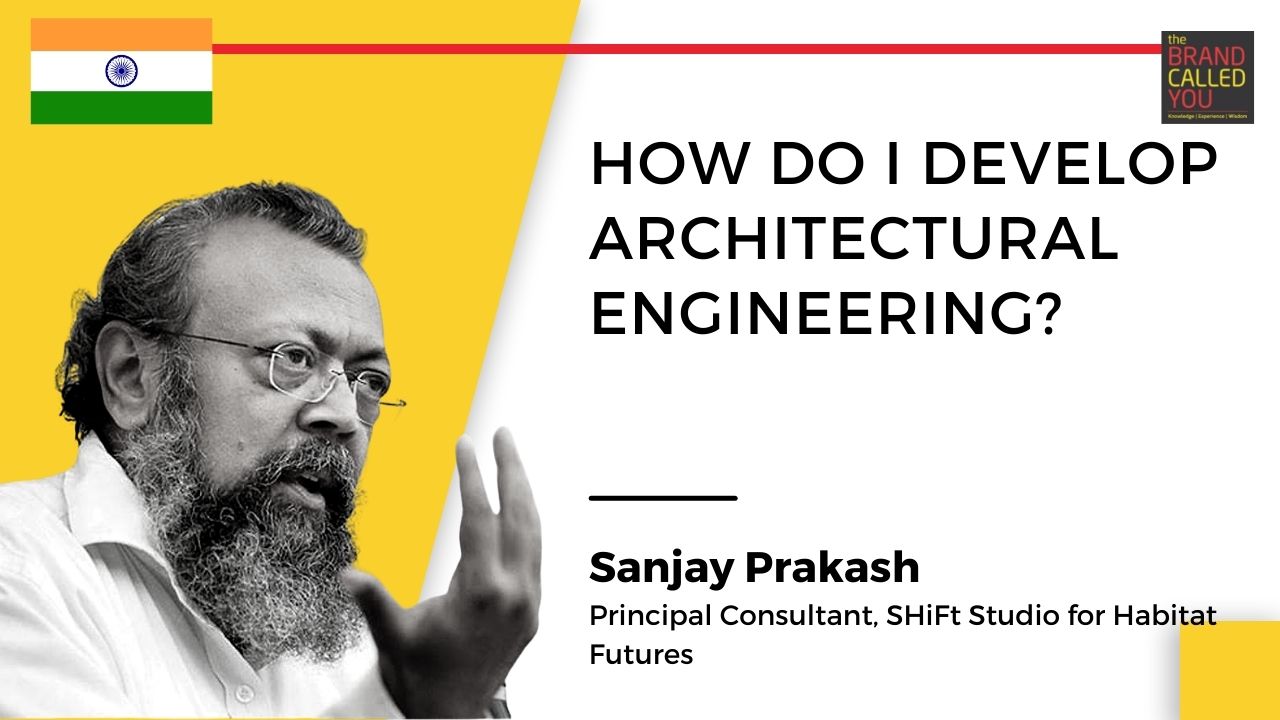Sanjay Prakash, Principal Consultant, SHiFt Studio for Habitat Futures
Sanjay Prakash, B. Arch., A.I.I.A., is an architect with a commitment to energy-conscious architecture, eco-friendly design, people’s participation in planning, music and production design.
Podcast
Overview
We all talk about how the earth is being overused and exploited by the greed of men. We often think of doing something to stop it but fail. Our guest for today, Sanjay Prakash, has been working towards making environmentally friendly buildings. He is an environmentally friendly architect. Sanjay Prakash is the principal consultant of Studio for Habitat Futures (SHiFt). He is the co-founder of Future Institute and Himalayan Institute of Alternatives. He is a senior advisor at the Indian Institute of Human Settlements. His name and work have been mentioned in the 20th edition of one of the main reference work in architectural history, A History of Architecture by Sir Bannister Fletcher.
Sanjay tells us that he has been fond of mathematics since childhood. Seeing things in a quantitative manner, he believes that the exchange between the earth and the human is lopsided. The exchange is not adding up to zero. We are taking more from the earth than giving it. For a better understanding, he gives us the example of the accounting principle where all the debits and credits cancel out and the results have to be zero. If it is not adding up to zero, either the calculations are not correct or there is some error in the data. He also states that his upbringing also plays a major role in developing his interest in architecture. These are the things that influenced him in developing Environmental Architecture, which he is now considered the father of.
Why does Sanjay like working with bamboo?
Sanjay tells us about the two most environmentally friendly materials, earth (excavated stuff) and bamboo. Out of these two, the earth takes millions of years to form whereas bamboo is one of the fastest-growing plants. Sanjay further tells us that bamboo’s tensile strength is similar to the strength of steel, it weighs 10% of the steel but is not weak in tension in that proportion. Hence, bamboo is a very good option when it comes to the formation of the basic structure of the building. Bamboo has many other uses. An Australian organisation is developing a sunscreen from bamboo. Bamboo is also being used to prepare beer etc. He believes that bamboo has tremendous potential to change the world we live in.
What does Sanjay mean by saying that he is migrating from practising architectural design to developing architectural engineering?
Due to Sanjay’s keen interest in mathematics, he has always seen architecture as a branch of material science and engineering. However, he says that he is learning that architecture is much more than material learning. He believes that he is an architectural engineer and architecture is a branch of engineering. However, the council concerned states that architecture is more poetic and aesthetic in nature, which Sanjay openly disagrees with.
Work that Sanjay is doing with water, waste and energy resources
Sanjay is working on a vision of managing a good life by using less water. He says that the average amount of water one needs every day is 135 litres and India is supplying about 60-80 litres per capita per day. Sanjay is doing research on this subject and has found out that with extreme recycling, we can manage with 60 litres per capita per day.
How is technology changing architecture?
In Sanjay’s opinion, technology has two different avatars when it comes to architecture. One is the highly defined technology that includes designs influenced by the industrialised west, like using glasses, steel, concrete etc. Another one is the delicate technology of using the material that is directly given by earth like bamboo. These things do not have a standard and are highly variable in nature. Thus, architecture for Sanjay becomes an art more than science. On which he believes that art and science constitute technology.
Profile
Sanjay Prakash, B. Arch., A.I.I.A., is an architect with a commitment to energy-conscious architecture, eco-friendly design, people’s participation in planning, music and production design. Over the years, he has integrated all his work with the practice of new urbanism and sustainability in his professional and personal life.
He is Principal Consultant of his design firm, SHiFt: Studio for Habitat Futures (formerly Sanjay Prakash & Associates), and was a partner of daat and Studio Plus, design firms that predate his current independent work. He currently employs about 30 professionals directly and has about 200 professionals including consultants and their employees working on projects being handled by him. He has been known to be an early adopter of computer aided design and bringing a systems orientation to architectural practice in the 1980s in India.
He is co-founder of Future Institute (fi) and Himalayan Institute for Alternatives, Ladakh (hial), and senior advisor, Indian Institute for Human Settlements (iihs).
Sanjay has also a keen interest and some experience in Systems Theory and simulation models, and has worked extensively to develop future scenarios and ecological planning methods. His area of practice and research over the last 30 years includes passive and low energy architecture, hybrid air-conditioning, autonomous energy and water systems, bamboo and earth construction, community-based design of common property, and computer-aided design.
The firm is migrating from practicing architectural design to developing architectural engineering and innovation, especially in the areas of materials, water, waste and energy resources. Due to this orientation it has developed capacities for in-house interdisciplinary work (architecture, structural and civil engineering, thermal simulation, electrical engineering, and purchase management.)
Under his guidance, hundreds of persons have developed capabilities in performing design, conceptual, or project management work in the above areas.
SHiFt is not a research firm, preferring to exist in the space between laboratory and field which is not bridged in India by technology developers, preferring to innovate with a ‘no alibis’ approach. This, and Sanjay’s desire to envision and develop the future, has made the firm take up management of projects and construction, renovation, and explore setting up an energy services company and a Research Institute.
Despite being an independently successful practitioner, Sanjay is associated with numerous other architects and design firms due to his conscious focus on collaborative work in order to be able to derive the advantage of differing areas of strength between peers. He is known for being a valued member of design teams and charrettes, including those with international peers such as Ken Yeang and Groupe6, of being a voracious technology watcher, and of keeping a future-oriented approach to his work.
His name and work is mentioned in the twentieth edition of one of the main reference works in architectural history, A History of Architecture by Sir Bannister Fletcher.


